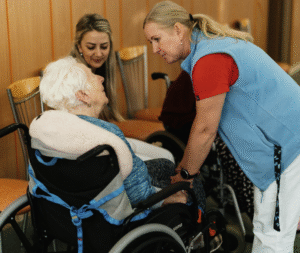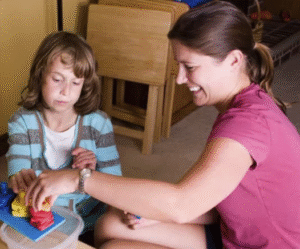So, once your little one is at least 6 months old, and meets the prerequisite criteria as outline in our previous post on when to introduce foods then what? Read more to find out about how to introduce and progress through foods and ways to make meal time a more interactive experience.
Well, there are 2 varying schools of thought on how to introduce and progress through foods:
Step 1: Introduce purees to your infant:
Introduce purees first, starting with stage 2 and progressing to more textured foods like oatmeal, then trial meltable solids like puffs and crackers, then finally add in mixed texture foods. When using a spoon, present the food slowly and wait for baby to open their mouth before pressing spoon forward. Wait for baby to lower the top lip to help clear the foods off of the spoon. The food should not be thrust out of the mouth, but managed in the mouth with movement of the tongue and a munching motion of the jaw.
Step 2: Infant led weaning:
This is a technique that avoids use of purees (besides foods like mashed potato which are naturally pureed). Soft solid foods (such as cooked sweet potato or ripe banana) are introduced and the little one is able to chew and swallow the foods. This is only safe if the child has proper trunk control and is able to effectively move the food around in the mouth to use the jaw or teeth to mash. This method is not for everyone, but there are very good outcomes.
When following the pre-requisites, it ensures that the baby is more developmentally appropriate and safe to manage the textured foods and solids.
Tips for fun mealtimes with your infant:
- Allow the baby to experience most of the foods you are eating (taking into account strong spices, extreme heat, or allergies) by touching it, mashing it, and interacting with it. Even if they do not try to bring it to their mouth, just interacting with the foods gives them sensory information (familiarity with the food’s smell, texture, etc) to help with future experiences.
- Use simple, descriptive language when interacting with the food “This carrot is hard!” “This cracker is crunchy” “Mash it!” etc.
- Make meal time and snack time a family time! Babies and toddlers (really almost anyone) are more likely to eat what they see others eating. If you are having a fruit, baby may be more interested in having the same fruit – share it! Toddlers begin to pick up on patterns and will notice if parents are eating junk food and they have to eat fruits and veggies!
- Remember that food before the age of 1 is mostly for fun. The bulk of their nutrition will come from breastmilk or formula at this age.
- Avoid expectations of how much a baby will or should eat. This can cause increased stress for all involved which can cause overall frustration and poor results.
- Vary the types, textures, and temperatures so that baby doesn’t get overly used to one particular temperature or flavor. Offer the same food in several ways – such as sauteed broccoli cooked in butter or oil, steamed broccoli with cheese on top, and sauteed broccoli with salt, pepper, and garlic. Some babies (especially those who were breastfed) prefer more flavorful food, and will turn up their nose to bland “typical baby food.”
A feeding therapist’s thoughts on introducing foods to your infant:
I personally have used the baby led method with 3 of my 4 kids (I didn’t know about it with my first, but even then he didn’t have many purees because he didn’t like them). With my 3rd child, I gave him a soft solid shortly after he was 6 months old, but he could not manage it safely and thrusted it out with his tongue.
I simply waited another month and allowed his body to progress and develop a bit more. When I tried again a month later, he did great and eating became enjoyable for everyone. I simply gave him soft cooked vegetables like chunks of cooked sweet potato, cooked broccoli, canned mixed beans, or soft fruits that we were having for dinner. He finger fed himself, which also works on fine motor skills and builds a feeling of independence and success!
Foundational skills/ pre-requisites for testing foods with your infant:
- Does the child show interest in foods? A very common sign that children are ready for foods is that they begin to open their mouth around foods, gaze at foods, or reach for foods when others are eating.
- Is the child able to sit up on their own? Core strength is necessary and develops before mouth and jaw strength. Think about the core being the base of the pyramid and the mouth being the top of the pyramid. The base should be strong in order to support the top.
- Is the child able to move their tongue around in their mouth? The tongue needs to be able to move side to side in order to safely move the food in order to chew it and to prepare to swallow.
- Does the child still have his automatic tongue thrust? This mechanism is designed to protect a baby from choking before the baby is ready to handle foods. If he still automatically thrusts foods or items using a pressing motion of the tongue forward, the tongue has not yet developed the necessary patterns for safe and effective eating. The body progresses from a sucking based method which uses the tongue thrust to a more mature chewing based pattern between 4 and 6 months of age, sometimes even later.
- If you put your finger in the child’s mouth near where the molars will be, do they bite down/munch on your finger? This automatic chewing motion is an early skill to practice chewing and will help them build strength and coordination for chewing foods.
If you think your child is in need of occupational, physical, or speech therapy call us today to set up a FREE screening at 586-323-2957!
Below are some additional resources:
Baby Lead Weaning: Growing Healthy Babies with Healthy Appetites
Written by: Cassie Whiteaker, MORTL




